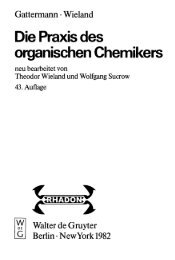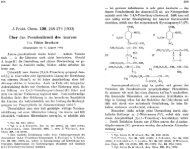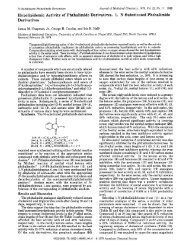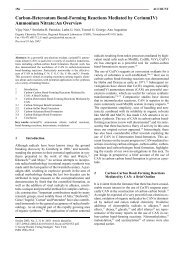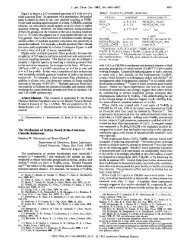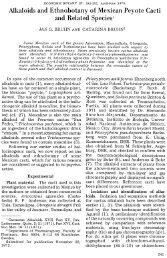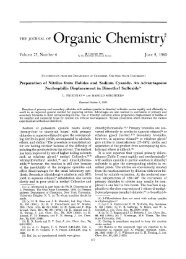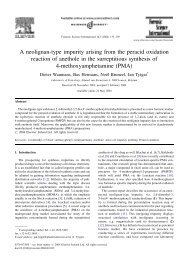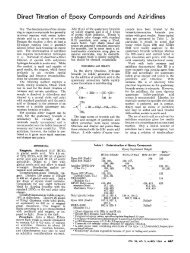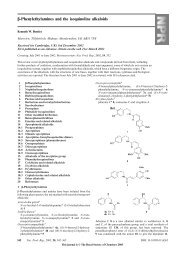You also want an ePaper? Increase the reach of your titles
YUMPU automatically turns print PDFs into web optimized ePapers that Google loves.
462 J. <strong>Org</strong>. <strong>Chem</strong>. 1990,55,462-466<br />
A Selective and Efficient Method for Alcohol Oxidations Mediated by<br />
N-Oxoammonium Salts in Combination with Sodium Bromite<br />
Tsutomu Inokuchi, Sigeaki Matsumoto, Tokio Nishiyama, and Sigeru Torii*<br />
Department of Applied <strong>Chem</strong>istry, Faculty of Engineering, Okayama University, Okayama, Japan 700<br />
Received June 16, 1989<br />
The oxidation of primary and secondary alcohols leading to aldehydes, carboxylic acids, and ketones has been<br />
carried out in a N-oxoammonium salts-NaBr02 system. Sodium bromite as a stoichiometric oxidizing reagent<br />
activates N-oxy1 compounds (recycling catalysts) to their N-oxoammonium salts in a weakly basic medium, which<br />
oxidize primary hydroxyl groups preferentially rather than secondary ones to the corresponding aldehydes. Calcium<br />
hypochlorite is used as an alternative terminal oxidant in the same media. The procedure, applicable to the<br />
selective formation of y- and 6-lactones, &hydroxy aldehydes, and 2-acetoxy ketones, is advantageous in terms<br />
of reagent cost, safety, and ease of operation.<br />
Oxidation of alcohols using metallic or nonmetallic<br />
catalysts with stoichiometric amounts of cooxidants is<br />
currently a practical 0peration.l However, use of even a<br />
catalytic amount of hazardous metallic reagents is a matter<br />
of economic and environmental concern.2 N-Oxoammonium<br />
salts3 as nonmetallic oxidizing reagents are<br />
available easily from the corresponding N-oxy1 radicals by<br />
treating with following reagents and methods: (a) positive<br />
halogen sources,4 (b) m-chloroperbenzoic (c) highvalency<br />
metal salts! and (d) electro~xidation.~ In particular,<br />
the search for a recycling system with N-oxoammonium<br />
salts has led to the development of efficient<br />
procedures by use of NaOC1-KBr8 and CUC~,--O~~ as a<br />
cooxidant. However, problems associated with these<br />
methods are, sooner or later, loss of the oxidizing power<br />
of the N-oxoammonium salts due to concurrently gener-<br />
ated hydrogen peroxide4" and molecular chlorine. We<br />
describe here a versatile procedure for the oxidation of<br />
alcohols with N-oxy1 compounds (catalysts)-sodium<br />
bromite (NaBr02, cooxidant)1° (Scheme I).<br />
Two-phase or mixed solvent systems were chosen for the<br />
following reasons: (a) different solubilities of organic and<br />
inorganic reagents, (b) easy operation and workup, and (c)<br />
(1) (a) Zhang, N.; Mann, C. M.; Shapley, P. A. J. Am. <strong>Chem</strong>. SOC. 1988,<br />
110, 6591. (b) Giddings, S.; Millis, A. J. <strong>Org</strong>. <strong>Chem</strong>. 1988,53, 1103. (c)<br />
Ishii, Y.; Yamawaki, K.; Ura, T.; Yamada, H.; Yoshida, T.; Ogawa, M. J.<br />
<strong>Org</strong>. <strong>Chem</strong>. 1988,53,3587. (d) Morris, P. E.; Kiely, D. E. J. <strong>Org</strong>. <strong>Chem</strong>.<br />
1987,52,1149. (e) Dess, D. B.; Martin, J. C. J. <strong>Org</strong>. <strong>Chem</strong>. 1983,48,4155,<br />
and references therein.<br />
(2) Kauffman, J. M.; Mckee, J. R. J. <strong>Chem</strong>. Educ. 1982,59, 862.<br />
(3) Rozantsen, E. G.; Sholle, V. D. Synthesis 1971, 401.<br />
(4) C12 or Brz: (a) Miyazawa, T.; Endo, T.; Shiihashi, S.; Okawara, M.<br />
J. <strong>Org</strong>. <strong>Chem</strong>. 1985,50,1332. (b) Miyazawa, T . Endo, T. J. <strong>Org</strong>. <strong>Chem</strong>.<br />
1985, 50, 3930. (c) Endo, T.; Miyazawa, T.; Sciihashi, S.; Okawara, M.<br />
J. Am. <strong>Chem</strong>. SOC. 1984,106,3877. XeF2: (d) Golubev, V. A.; Salmina,<br />
N. N.; Korsunskii, B. L.; Aleinikov, N. N. Zzu. Akad. Nauk SSSR, Ser.<br />
Khim. 1978,778; <strong>Chem</strong>. Abstr. 1978,89,42006z. HOC1: (e) Petrov, A.<br />
N.; Kozlov, Yu. N.; Purmal, A. P.; Uskov, A. M. Zh. Fiz. Khim. 1984,58,<br />
2109; <strong>Chem</strong>. Abstr. 1984, 101, 210302e. FC103: (0 Vigalok, A. A.; Lukashina,<br />
S. G.; Petrova, G. G.; Vigalok, I. V.; Levin, Ya. A. Zh. <strong>Org</strong>. Khim.<br />
1987,23,489; <strong>Chem</strong>. Abstr. 1987, 107, 235828t.<br />
(5) Cella, J. A.; Kelley, J. A,; Kenehan, E. F. J. Og. <strong>Chem</strong>. 1975, 40,<br />
1860.<br />
(6) K3[Fe(CN),]: (a) Miyazawa, T.; Endo, T. J. Mol. Catal. 1985,31,<br />
217. CuX2 (X = C1, Br, OAc, etc.): (b) Miyazawa, T.; Endo, T. J. Mol.<br />
Catal. 1985, 32, 357.<br />
(7) Semmelhack, M. F.; Chou, C. S.; Cortes, D. A. J. Am. <strong>Chem</strong>. SOC.<br />
1983, 105,4492.<br />
(8) Anelli, P. L.; Biffi, C.; Montanari, F.; Quici, S. J. Og. <strong>Chem</strong>. 1987,<br />
52, 2559.<br />
(9) Semmelhack, M. F.; Schmid, C. R.; Cortes, D. A.; Chou, C. S. J.<br />
Am. <strong>Chem</strong>. SOC. 1984,106, 3374.<br />
(10) Review on NaBr02 as an oxidant: Okawara, M. J. Synth. <strong>Org</strong>.<br />
<strong>Chem</strong>. Jpn. 1984,42, 751.<br />
Scheme I<br />
la-NaBr02 1a-NaBrO2<br />
RCHO<br />
RCo2H M&N. RCH20H CH2C12-<br />
5 aq 0 5%NaHCOI 3 aq 5%NaHCO1 4<br />
NaBr02 AcOH-H20 I RCO~CHPR<br />
6<br />
instability of N-oxoammonium salts in aqueous media."<br />
After a survey on solvent effects, methylene chloride was<br />
found to be the best choice for the oxidation of primary<br />
alcohols to the corresponding aldehydes. The pH of the<br />
aqueous phase was maintained slightly basic with buffer<br />
solutions. Thus, the reaction of undecanol (3a) with a<br />
catalytic<br />
&<br />
amount of 4-(benzoyloxy)-2,2,6,6-tetramethylpiperidine-1-oxy1<br />
(la, 1 mol 5%) and 3 equiv of sodium<br />
G C H 2 ) 6 &<br />
I I I<br />
0. 0. 0.<br />
6 Y -<br />
la, X=OCOPh Id 2. Y = Br, CI<br />
lb, X=CN<br />
IC, X=OMe<br />
bromite in a CH2Cl2-Hz0 (buffered at pH 8.6 with NaH-<br />
CO,, 1:2 v/v) system afforded undecanal(4a) in 93% yield<br />
(Table I, entry 1). The oxidation of 3a to the corre-<br />
sponding carboxylic acid 5a was performed in 92 % yield<br />
with the two-reagents combination in a homogeneous<br />
MeCN-H20 (1:l v/v) system (entry 2). The conversion<br />
of the reagent la to N-oxoammonium salt 2a is probably<br />
enhanced in the homogeneous medium so that further<br />
oxidation of the aldehyde 4a to the carboxylic acid 5a<br />
proceeds smoothly. On the other hand, the reaction of 3a<br />
with sodium bromite in an AcOH-H20 (15 v/v) system<br />
produced only the dimeric ester 6a in 92% yield (entry 3)<br />
in accordance with the results reported by Kageyama et<br />
all2 The ester 6a was partially formed when the oxidation<br />
of 3a was carried out in a la-NaBr02 system under neutral<br />
to weakly acidic conditions (entries 4 and 5).<br />
The time-dependence curves of the conversion yields of<br />
4a from 3a under various added amounts of the oxidant<br />
la are plotted in Figure 1. The oxidation of 3a to 4a is<br />
(11) Dagonneau, M.; Kagan, E. S.; Mikhailov, V. I.; Rozantsev, E. G.;<br />
Sholle, V. D. Synthesis 1984, 895. Our attempts to isolate the oxo-<br />
ammonium salt 2a (Y = Br) from la by the oxidation with NaBr02 (3<br />
equiv) in a CHzClz-aqueous 5% NaHC03 (1:l v/v) were unsuccessful, but<br />
the starting la was recovered quantitatively presumably because of rapid<br />
reduction of the formed oxoammonium salt 2a with water.<br />
(12) Kageyama, T.; Kawahara. S.: Kitamura, K.; Ueno, Y.; Okawara,<br />
M. <strong>Chem</strong>. Lett. 1983. 1097<br />
0022-3263/90/1955-0462$02.50/0 0 1990 American <strong>Chem</strong>ical Society
Alcohol Oxidations Mediated by N-Oxoammonium Salts J. <strong>Org</strong>. <strong>Chem</strong>., Vol. 55, No. 2, 1990 463<br />
Table 1. Oxidation of Undecanol (34 by N-Oxy1 (la)-NaBrO, andlor Ca(OCI), Caoxidants'<br />
product yield, %<br />
entry solvent (pH, v/v) oxidizing reagent 4a 5s 6a<br />
1<br />
2<br />
3<br />
CH,CI,-H,O (pH 8.6, 12)<br />
MeCN-H,O (pH 8.6, 1:l)<br />
AcOH-H.0 loH 2.2. 1:5)<br />
la (1 mol %)-NaBrO, (3 equiv)<br />
la (1 mol %)-NaBrOl (3 equiv)<br />
NaBrO. 13 eouidb<br />
93<br />
92<br />
92 _-<br />
5<br />
34<br />
"Unless otherwise noted, reactions were carried out by using 3a (1.0 mmol) in organic solvent (5 mL) and aqueous solution (5-10 mL) at<br />
raom temperature for 15-180 min. 'N-Oxy1 la was not present. c50 mmol of 3a was used see Experimental Section.<br />
0 15 30 45<br />
Time (min)<br />
Figure 1. Time-dependence curves for oxidation of undecanol<br />
(34 with N-oxy1 (la)-NaBrO, (-) or la-Ca(OCI), (---I system.<br />
Symbols are as follows: 5 mol % of la (0); 1 mol % of la (0);<br />
0.2 mol % of la (Oh in the absence of la (A). Data points were<br />
obtained by GC analyses based on an internal standard (bromononane).<br />
accelerated by increasing the catalyst amount and reasonable<br />
rates were obtained in the range 1-5 mol % of la.<br />
Routinely, we used 1 mol % of la (based on the substrate)<br />
for the oxidation, which facilitated the separation of<br />
products from the catalyst la by distillation or chromatograph~.'~<br />
Subsequently, the oxidation of 3a to 4a was attempted<br />
using the tetramethylpiperidine-1-oxy1 derivatives Ib, IC,<br />
and Id, affording 4a in 98% (with Ib), 85% (with IC), and<br />
97% yields (with Id). In contrast, di-tert-butylnitroxyl<br />
was not useful as a recycling catalyst.<br />
Competitive oxidation of 1-undecanol (3a) and 2-undecanol(7a)<br />
under the conditions of entry 1 (Table I) was<br />
examined at 0 OC, and the yields of undecanal (4a) and<br />
2-undecanone (8a) are plotted in Figure 2 as a function<br />
of the amount of sodium bromite. Aldehyde 4a was exclusively<br />
formed when less than 3 equiv of sodium bromite<br />
was used. Similarly, treatment of a 1:l mixture of l-dodecanol<br />
(3b) and 4-dodecanol (7b) with la (1 mol %)-<br />
NaBrO, (4 equiv) at 0 "C afforded dodecanal (4b) and<br />
4-dodecanone (8b) in 92% and 2% yields, respectively. In<br />
the latter case, the relative oxidation rates for 4b and 8b<br />
can be estimated to he in a ratio of 461. This value compares<br />
well with that obtained by the oxidation with ruthenium<br />
dichloride tris(tripheny1pbosphine) complex,<br />
(RuCI,(PPh,),), as a stoichiometric oxidant in benzene.14<br />
3b<br />
7b OH<br />
-CHO<br />
4b<br />
,----P,<br />
8b<br />
(13) After completion of the reaction, ex- oxidants can be removed<br />
by adding ethanol in the aldehyde synthesis or aqueous 5% sodium<br />
hydrogen sulfite in the ketone synthesis.<br />
.<br />
0 1.0 2.0 3.0 4.0<br />
NaBrOI (equivalent)<br />
Figure 2. Competitive oxidation of undecanol(3a) and 2-undecanol.<br />
Symbols me as follows: undecanal (o), 2-undecanone<br />
(0). Data points were based on isolated products.<br />
As an alternative oxygenated halogen oxidant, calcium<br />
hypochlorite (Ca(OCl),) could be used for the present<br />
purpose.15 As shown in entry 6 (Table I), the oxidation<br />
of 3a in a CH,CI,-H,O (buffered at pH 8.6, 1:2 v/v)-la<br />
(1 mol %)-Ca(OCI), (2.2 equiv) system at 0-5 "C gave<br />
aldehyde 4a in 90% yield. The oxidation of 3a with a<br />
laCa(OCI), system proceeded more rapidly than that with<br />
a la-NaBr02 system.16 On the other hand, the use of<br />
sodium chlorite (NaCIOJ and sodium periodide (NaIO,)<br />
as a stoichiometric oxidizing reagent was unsuccessful.<br />
In contrast to our present method, the recently developed<br />
4-methoxy-2,2,6,6-tetramethylpiperidine-l-oxyl (Id,<br />
catalytic)-KBr (catalytic)-NaOC1 (stoichiometric) system8<br />
needs ultrarapid agitation to complete the reaction quickly.<br />
Furthermore, the la-NaBrO, system can be operated<br />
easily in a large-scale p~eparation.'~<br />
The results from oxidation of a variety of primary and<br />
secondary alcohols are listed in Table 11. The oxidation<br />
of terminal 1,4- and 1,5-diols can lead toy- and &lactones<br />
(entries 16-19), while terminal l,&diols are converted to<br />
&hydroxy aldehydes (aldols) due to mild reaction conditions<br />
(entries 13-15). For the oxidation of secondary alcohols<br />
in 1,3-diol derivatives, the sodium hypochlorite<br />
acetic acid system, a typidy economical method, has been<br />
recognized as a particularly useful one.18 The present<br />
1141 Tomioka. H.: Takai, K.: Oihima. K.: Nomki, H. Tetrohedmn<br />
ktt. 1981, 22, 1605.<br />
(151 Oxidation with Cs(OCI12 in acetic acid Nwauks, S. D.; Keehn.<br />
P. M. Telrohpdron I.ett. 1982.23. . ~, 3131.<br />
~~~~~<br />
(16) The oxidation with la-Ca(OCI), wag carried out with a 0.2 M<br />
solution of substrate in CH2CI2, and Ca(OCI), was added portionwise to<br />
the reaction mixture. At about 1 M concentration loss of N-oxy1 compounds<br />
occurred prior to the end point.<br />
(11) The oxidation of 3a (10 mmol) with a combination of la (0.1<br />
mmol) and KBr (1 mmol)-NaOCI (30 mmoll in B CH,CI, (50 mL)aqueous<br />
5% NaHCO, (45 mL) at &5 OC for 3 h resulted in the formation<br />
of 4a (35%) and recovery of the starting 3a (64%).
464 J. <strong>Org</strong>. <strong>Chem</strong>., Vol. 55, No. 2, 1990 Inokuchi et al.<br />
Table 11. Oxidation of Primary and Secondary Alcohols bv N-Oxvl (1abNaBrO. or laCa(OC1L"<br />
entry substrate<br />
1<br />
2<br />
3<br />
4<br />
5<br />
6<br />
6'<br />
7<br />
7'<br />
8<br />
9<br />
10<br />
11<br />
12<br />
13<br />
14<br />
15<br />
16<br />
17<br />
18<br />
19<br />
20<br />
20'<br />
21<br />
21'<br />
22<br />
22'<br />
23<br />
24<br />
octanol<br />
dodecanol<br />
octadecanol<br />
L O H<br />
W""<br />
T OH O H<br />
WoH<br />
Y O A c<br />
oxidantb<br />
(eauiv/ time)<br />
yield:<br />
Droduct %<br />
octanal<br />
dodecanal<br />
octadecanal<br />
@CHO<br />
96<br />
96 rCHO<br />
P C H O<br />
OH<br />
4 COH H O<br />
E C H O<br />
'Ph<br />
CYo<br />
oo<br />
-To<br />
"Substrate (1 mmol) was reacted with la (0.01 mmol) in CH2ClZ (5 mL)-aqueous 5% NaHC03 (10 mL). boxidant A, NaBr02; oxidant B,<br />
Ca(OCUZ. Yields based on isolated products.<br />
procedure provides a complement to the above method for<br />
the selective oxidation of 1,3-diols in the reverse manner<br />
without noticeable isomerization (entries 14 and 15).19<br />
(la) Stevens, R. V.; Chapman, K. T.; Weller, H. N. J. <strong>Org</strong>. <strong>Chem</strong>. 1980,<br />
45, 2030.<br />
0<br />
OAc<br />
80<br />
98<br />
96<br />
57<br />
90<br />
95<br />
82<br />
68<br />
76<br />
53<br />
69<br />
77<br />
86<br />
96<br />
94<br />
95<br />
99<br />
94<br />
86<br />
97<br />
89<br />
99<br />
76<br />
92<br />
81<br />
95<br />
1,2-Diol monoacetates yielded the corresponding 2-acetoxy<br />
ketones without cleaving the carbon-carbon bond (entries<br />
(19) Optically active 2-benzyl-3-hydroxybutanal was unstable to<br />
chromatography on SiOp or Florisil column and isomerized on standing<br />
at room temperature for few hours. Optical Purity and the elemental<br />
analysis of this compound were not determined.<br />
87
Alcohol Oxidations Mediated by N-Oxoammonium Salts<br />
23 and 24).<br />
Sodium bromite (Na13r02)20 is intermediate in oxidation<br />
state between sodium hypobromite (NaOBr) and sodium<br />
bromate (Na13r03), the latter of which is not useful for the<br />
present purpose as a cooxidant. An aqueous solution of<br />
NaBr02 at pH 6-8 is proposed to be trimeric, and due to<br />
self-decomposition property at this pH region, the reactivity<br />
as an oxidant is mild, in contrast to that under<br />
acidic conditions.21i22 Such a characteristic nature of<br />
sodium bromite, being specifically effective as an oxidant<br />
for the conversion of N-oxy1 1 to N-oxoammonium salts<br />
2, is adequate for a selective oxidation of alcohols under<br />
mild conditions without loss of the catalyst activity.<br />
Furthermore, as far as NaBr02 is employed as a cooxidant,<br />
the operation described here is quite safe since the reaction<br />
proceeds at a moderate rate (Figure l), and NaBr02 in<br />
basic media liberates no molecular bromine.21<br />
Experimental Section<br />
General Procedures.B Sodium bromite (NaBr02.3H20, 65%<br />
pure as NaBrO,, Kanto Kagaku, Japan) and calcium hypochlorite<br />
(60% pure, Santoku <strong>Chem</strong>ical, Japan) were used as received.<br />
2,2,6,6-Tetramethylpiperidine-l-oxyls (la-d) were prepared from<br />
the corresponding 2,2,6,64etramethylpiperidine according to the<br />
method reportedz4 and purified by recrystallizations or column<br />
chromatography. Starting alcohols were purified by distillation<br />
or column chromatography (SiO,) prior to use.<br />
Oxidation of Primary Alcohols to Aldehydes. Typical<br />
Procedure. Undecanol (3a, 1.72 g, 10 mmol) and 4-(benzoyloxy)-2,2,6,6-tetramethylpiperidine-l-oxyl<br />
(la, 28 mg, 0.1 mmol)<br />
were dissolved in CH2C12 (50 mL) and combined with aqueous<br />
5% NaHC0, (100 mL). On cooling to 0-5 "C, NaBrOz-3H20 (6.2<br />
g, 30 mmol) was added to the above mixture with moderate<br />
stirring. Stirring was continued for an additional 3 h at room<br />
temperature, and ethanol (5 drops) was added. The organic layer<br />
was separated, and the aqueous layer was extracted with CH2Cl2<br />
Combined extracts were washed with brine, dried (Na2S0,), and<br />
concentrated. Flash chromatography of the residue on silica gel<br />
(hexane-AcOEt 1O:l) gave 1.58 g (93%) of undecanal(4a) as an<br />
oil: bp 113 "C (9 mmHg); IR (neat) 2716,1729 (M), 1466 cm-';<br />
'H NMR (500 MHz) 6 0.88 (t, J = 7.0 Hz, 3, CH3), 1.26 (br s, 14,<br />
CH,), 1.62 (m, 2, CH,), 2.41 (dt, J = 7.3, 2.0 Hz, 2, CH,CO), 9.76<br />
(t, J = 2.0 Hz, 1, CHO); 13C NMR (126 MHz) 6 14.1, 22.1, 22.7,<br />
19.2, 29.29, 29.34, 29.4, 29.5, 31.9, 43.9, 203.0.<br />
Oxidation of Primary Alcohol to the Carboxylic Acid. The<br />
alcohol 3a (1.72 g, 10 mmol) and la (28 mg, 0.1 mmol) were<br />
dissolved in MeCN (100 mL) and mixed with aqueous 5%<br />
NaHC03 (100 mL). To this homogeneous solution was added<br />
portionwise NaBr02-3Hz0 (8.30 g, 40 mmol) at 0-5 "C, and the<br />
mixture was stirred vigorously for an additional 3 h at room<br />
temperature. The mixture was acidified with 10% tartaric acid<br />
and taken up in AcOEt (50 mL X 3). Extracts were washed with<br />
brine, dried (Na2S04), and concentrated under vacuum. Chro-<br />
(20) Crystalline NaBrO, is stable in the dark and undergoes dispro-<br />
portionation on heating.,l Aqueous NaBrO, solution is shown to be<br />
trimeric at pH 6-8.,*<br />
3NaBr0, - 2NaBr03 + NaBr (at 109 "C)<br />
2NaBrOB - 2NaBr + 30, (at 359 "C)<br />
'Br /-Na<br />
0-Na<br />
'-Br' -Na<br />
'*Br'<br />
'0-<br />
(21) Kageyama, T. J. <strong>Chem</strong>. SOC. Jpn. 1972, 1064.<br />
(22) Techinical Bulletin on sodium bromite from Nippon Silica Industrial<br />
Co., 1984.<br />
(23) All reactions were carried out under an argon atmosphere.<br />
Melting points and boiling points indicated by an air-bath temperature<br />
are uncorrected. GC analyses were carried out on a Yanagimoto Model<br />
G6800 with a Quadrex bond-fused silica capillary column (methylsilicone:<br />
0.25-rm film thickness, 25 m X 0.25-m i.d.). 'H NMR and 13C NMR<br />
spectra were recorded in CDC1,.<br />
(24) Rozantsev, E. G.; Neiman, M. B. Tetrahedron 1964, 20, 131.<br />
J. <strong>Org</strong>. <strong>Chem</strong>., Vol. 55, No. 2, 1990 465<br />
matographic purification (hexane-AcOEt 1:l) of the crude<br />
products gave 1.71 g (92%) of undecanoic acid (5a): mp 28 OC;<br />
IR (KBr) 3500-2500 (COOH), 1698 (C=O), 1468,1435,1412,1290,<br />
932 cm-'; 'H NMR (60 MHz) 6 0.87 (t, 3, CH,), 1.25 (br s, 16, CHd,<br />
2.31 (t, J = 6.7 Hz, 2, CH,CO), 11.37 (br s, 1, COOH).<br />
Oxidation of Primary Alcohol to the Dimeric Ester. To<br />
a solution of 3a (172 mg, 1 mmol) in AcOH (0.2 mL) was added<br />
aqueous NaBrOz.3H20 (622 mg, 3 mmol) in H20 (1 mL) at room<br />
temperature over 30 min. After stirring for 12 h, the mixture was<br />
neutralized with aqueous NaHCO, and extracted with CH,Cl,.<br />
Extracts were washed with brine, dried (Na2S04), and concentrated.<br />
Chromatographic purification (hexane-AcOEt 15:l) of<br />
the crude products gave 158 mg (92%) of undecanyl undecanoate<br />
(6a) as an oil: IR (neat) 1742 (COO), 1466,1379,1241,1170,1114<br />
cm-'; 'H NMR (500 MHz) 6 0.88 (t, J = 7.5 Hz, 6, CH,), 1.26 (br<br />
s, 30, CH,), 1.61 (m, 4, CH,), 2.28 (t, J = 7.5 Hz, 2, CH,), 4.05<br />
(t, J = 6.5 Hz, 2, CH,O).<br />
Oxidation of Secondary Alcohols to the Ketones. Typical<br />
Procedure. A solution of 4-tert-butylcyclohexanol (7.81 g, 50<br />
mmol) and 4-(benzoyloxy)-2,2,6,6-tetramethylpiperidine-l-oxy~<br />
(la, 138 mg, 0.5 mmol) in CH2C12 (100 mL) was combined with<br />
aqueous 5% NaHC03 (100 mL). To this biphase mixture was<br />
added portionwise NaBr02.3H20 (31.2 g, 150 "01) with vigorous<br />
stirring and cooling in an ice bath. Stirring was continued for<br />
an additional 3 h at room temperature, and the reaction was<br />
quenched with aqueous 5% sodium bisulfate (3 mL). The mixture<br />
was worked up in the usual manner, and the crude products were<br />
distilled to give 6.86 g (89%) of 4-tert-butylcyclohexanone: mp<br />
48-49 "C (from hexane).<br />
Oxidation of l,4-Dihydroxyl Compounds to the y-Lactones.<br />
Typical Procedure. l&Decanediol (174 mg, 1.0 mmol)<br />
and la (2.8 mg, 0.01 mmol) were dissolved in CH2Clz (5 mL) and<br />
combined with aqueous 5% NaHC0, (10 mL). To this two-phase<br />
solution was added NaBrO2-3H20 (832 mg, 4 mmol) with vigorous<br />
stirring and cooling with an ice bath. Stirring was continued for<br />
an additional 3 h at room temperature. The organic layer was<br />
separated, and the aqueous layer was extracted with CH2C12.<br />
Combined extracts were washed with 5% sodium bisulfate, dried<br />
(Na2S04), and concentrated. Chromatographic purification of<br />
the crude products gave 168 mg (99%) of decan-4-olide: bp<br />
136-138 "C (9 mmHg) (lit.% bp 84 "C (0.2 mmHg)); IR (neat) 1770<br />
(C=O), 1465, 1170,900 cm-'; 'H NMR (200 MHz) 6 0.88 (t, J =<br />
6.6 Hz, 3, CH3), 1.29 (m, 6, CH,), 1.4-1.80 (m, 4, CH,), 1.80-1.98<br />
(m, 2, CH,), 2.32-2.68 (m, 2, CH,CO), 4.20-4.35 (m, 1, CHO);13C<br />
NMR (50 MHz) 6 14.6, 19.1, 23.1, 25.2, 28.4, 30.1, 32.2, 36.4, 81.2,<br />
172.6.<br />
Oxidation of 1,3-Diols to the Corresponding Aldols. A<br />
solution of 2-ethyl-1,3-hexanediol (4.39 g, 30 mmol; 1.3-1.4:1<br />
stereoisomers on 'Y! NMR) in CH2CI2 (50 mL) was combined with<br />
aqueous 5% NaHC0, (100 mL) and cooled to 0-5 "C. To this<br />
two-layer solution was added la (83 mg, 0.3 mmol) and then<br />
NaBrOz.3H,0 (18.7 g, 90 mmol) with moderate stirring. After<br />
this stirred for an additional 3 h at room temperature, ethanol<br />
(5 drops) was added. The organic layer was separated, and the<br />
aqueous layer was extracted with CH2Cl2 Combined extracts were<br />
washed with brine, dried (Na2S04), and concentrated to give 4.14<br />
g (96%) of 2-ethyl-3-hydroxyhexanal(1.3-1.4:1 stereoisomers on<br />
13C NMR): bp 101 "C (9 mmHg) (lit.26 bp 107-110 "C (16<br />
mmHg)); IR (neat) 3330 (OH), 2734, 1721 (C=O), 1464, 1381,<br />
1149, 1125, 977 cm-'; 'H NMR (500 MHz) 6 0.94, 0.95, 0.99 (t,<br />
J = 8 Hz, 6, CH3), 1.30-1.58 (m, 4, CH2), 1.62-1.84 (m, 4, CH,),<br />
1.94, 2.13 (br, 1, OH), 2.26, 2.31 (m, 1, CHCO), 3.88, 3.98 (m, 1,<br />
CHO), 9.75, 9.77 (d, J = 3, 2 Hz, 1, CHO); 13C NMR (126 MHz)<br />
6 11.5, 12.2, 13.83, 13.85, 17.5, 18.7, 19.1, 19.4, 36.5, 37.1, 58.61,<br />
58.70, 70.5, 70.8, 205.6, 205.9.<br />
(2R,3R)-2-Benzyl-3-hydroxybutanal(93:7 stereoisomers on 13C<br />
NMR) was obtained in 94% yield by the similar oxidation of<br />
(2S,3R)-2-benzyl-1,3-butanediol(955 stereoisomers on lSC NMR)<br />
as above at 0 "C. The starting diol was prepared by reduction<br />
of ethyl (2R,3R)-2-benzyl-3-hydroxybutanoate with LiAlH,.,'<br />
Spectral data of the crude aldol:19 IR (neat) 3332 (OH), 2735,<br />
(25) Kharasch, M. S.; Skell, P. S.; Fisher, P. J. Am. <strong>Chem</strong>. soc.1948,<br />
70, 1055.<br />
(26) Blanc, P. Y.; Perret, A,; Teppa. F. Helu. Chim. Acta 1964,47,567.<br />
(27) Frater, G. Helu. Chim. Acta 1979, 62, 2825.
466 J. <strong>Org</strong>. <strong>Chem</strong>., Vol. 55, No. 2, 1990<br />
1717,1605, 1497,1456,1379,1267,1118,917,739,702 cm-'; 'H<br />
NMR (200 MHz) 6 1.25 (d,J = 6.4 Hz, 3, CH,), 2.60 (m, 1, CHCO),<br />
2.82-3.01 (m, 2, CH,), 3.95 (m, 1, CHO), 7.11-7.28 (m, 5, PhH),<br />
9.73 (d, J = 2 Hz, 1, CHO); 13C NMR (50 MHz) 6 21.5, 32.3, 51.9,<br />
67.0, 126.4, 128.7, 128.8, 138.1, 205.0.<br />
Oxidation of a Mixture of Primary and Secondary Alcohols,<br />
a Competition Reaction. A mixture of 3a (172 mg, 1.0<br />
mmol), 2-undecanol (7a, 172 mg, 1.0 mmol), and la (5.6 mg, 0.02<br />
mmol) was dissolved in CHzClz (10 mL) and combined with<br />
aqueous 5% NaHC0, (20 mL). To this mixture was added<br />
NaBrO2.3H2O (624 mg, 3 mmol) with vigorous stirring under<br />
cooling on an ice bath. The mixture was stirred for an additional<br />
1 h at 0 "C and worked up in the usual manner. Purification of<br />
the crude oils by column chromatography (hexane-AcOEt 1O:l)<br />
gave 157 mg (91%) of 4a, 14 mg (8%) of 3a, and 163 mg (95%)<br />
of 2-undecanol (7a).<br />
Similarly, a mixture of l-dodecanol(3b, 186 mg, 1.0 mmol) and<br />
4-dodecanol (7b, 186 mg, 1.0 mmol) in CH2Cl, (10 mL) was oxidized<br />
with la (2.8 mg, 0.01 mmol) and NaBrO2.3Hz0 (832 mg,<br />
4.0 mmol) at 0 "C for 2 h. Usual workup followed by purification<br />
on SiO, (hexaneAcOEt 151) gave dodecanal(4b, 170 mg, 92%)<br />
and Cdodecanone (8b, 4 mg, 2%). 4-Dodecanone (4a):14 IR (neat)<br />
1717 (C=O) cm-'; 'H NMR (500 MHz) 6 0.86 (t, J = 7.1 Hz, 3,<br />
CH,), 0.90 (t, J = 7.4 Hz, 3, CH3), 1.26 (br, 8, CH2), 1.54 (m, 2,<br />
CH,), 1.58 (m, 2, CH,), 2.36, 2.37 (9, J = 7.4 Hz, 4, CH,).<br />
Oxidation of Primary Alcohols to Aldehydes by a la-<br />
Ca(OCl), System. Typical Procedure. Undecanol (3a, 8.62<br />
g, 50 mmol) and la (138 mg, 0.5 mmol) was placed in a biphase<br />
solution of CHzClz (250 mL)-aqueous 5% NaHC03 (500 mL). On<br />
cooling to 0-5 "C, Ca(OCl), (13.1 g, 55 mmol) was added portionwise<br />
to this mixture with a vigorous stirring. Stirring was<br />
continued for an additional 10 min at le15 "C. Precipitates were<br />
filtered, and the combined filtrates and washings were washed<br />
with 5% sodium bisulfate, dried (Na2S04), and concentrated.<br />
Purification of the crude produch by distillation gave 7.66 g (90%)<br />
of undecanal (4a): bp 113 "C (9 mmHg).<br />
Spectral data of some selected products listed in Table I are<br />
as follows.<br />
2-Tetradecynal: bp 98-100 "C (0.2 mmHg) (lit.,* bp 94-98<br />
"C (0.3 mmHg)); IR (neat) 2740,2282,2204,1673 (C=O), 1466,<br />
1139; 'H NMR (200 MHz) 6 0.88 (t, J = 6.5 Hz, 3, CH,), 1.25 (br<br />
s, 16, CH,), 1.52-1.63 (m, 2, CH,), 2.40 (t, J = 7 Hz, 2, CH,), 9.17<br />
(t, J = 1 Hz, 1, CHO); 13C NMR (50 MHz) 6 14.1, 19.1, 22.7, 27.5,<br />
28.8, 29.0, 29.3, 29.4, 29.6 (2C), 31.9, 81.7, 99.4, 177.3.<br />
5-Ethyl-3-formyl-2-methylpyridine: bp 115-117 "C (15<br />
mmHg); IR (neat) 2740,1692 (C=O), 1603,1557,1466,1288,1151,<br />
1009,729 cm-'; 'H NMR (500 MHz) 6 1.25 (t, J = 7.5 Hz, 3, CH,),<br />
2.68 (4, J = 7.5 Hz, 2, CHZ), 2.82 (s, 3, CH3), 7.90 (9, 1, CH-C),<br />
8.50 (s,l, CH=C), 10.30 (s,l, CHO); 13C NMR (126 MHz) 6 15.28,<br />
21.95, 25.66, 129.27, 137.29, 137.70, 153.31, 157.83, 191.83. Anal.<br />
Calcd for CSHllNO: C, 72.46; H, 7.43; N, 9.39. Found: C, 72.08;<br />
H, 7.21; N, 9.38.<br />
24 1-Hydroxycyclohexyl)propanal: IR (neat) 3426 (OH),<br />
2738, 1719 (C=O) cm-'; 'H NMR (500 MHz) 6 1.13 (d, J = 7.0<br />
Hz, 3, CH3), 1.24 (m, 1, CH,), 1.42 (m, 1, CH,), 1.50-1.66 (m, 8,<br />
CH,), 2.04 (s, 1, OH), 2.43 (m, 1, CHCO), 9.83 (d, J = 2 Hz, 1,<br />
CHO); 13C NMR (126 MHz) 6 8.6, 21.4, 21.5, 25.5,34.4, 36.2, 55.1,<br />
72.8, 206.2. Anal. Calcd for CgHl6O2: C, 69.19; H, 10.32. Found:<br />
C, 68.81; H, 10.51.<br />
(28) Wailes, P. C. Aust. J. <strong>Chem</strong>. 1959, 12, 173.<br />
Inokuchi et al.<br />
1-Acetoxy-2-dodecanone: mp 64-65 "C (from hexane); IR<br />
(KBr) 1754 (COO), 1725 (C=O), 1462, 1410, 1379, 1234, 1085,<br />
1052, 1036 cm-'; 'H NMR (500 MHz) 6 0.87 (t, J = 7 Hz, 3, CH,),<br />
1.25, 1.27 (br, 14, CH,), 1.57-1.64 (m, 2, CH,), 2.16 (9, 3, OAc),<br />
2.40 (t, J = 7.5 Hz, 2, CH,CO), 4.64 (s, 2, CH,O); 13C NMR (126<br />
MHz) 6 14.1, 20.5, 22.6, 23.3, 29.1, 29.26, 29.30, 29.40, 29.51, 31.9,<br />
38.8, 67.9, 170.2, 204.0. Anal. Calcd for C14H2603: C, 69.38; H,<br />
10.81. Found: C, 69.14; H, 11.22.<br />
2-Acetoxycyclohexanone: bp 114-116 "C (9 mmHg) (litez9<br />
bp 120-123 "C (12 mmHg)); IR (neat) 1748 (COO), 1727 (C=O),<br />
1454,1435, 1379, 1241,1085,1071 cm-'; 'H NMR (500 MHz) 6<br />
1.56-1.65 (m, 1, CH,), 1.66-1.80 (m, 2, CH,), 1.96 (m, 1, CH,),<br />
2.05-2.11 (m, 1, CH,), 2.15 (s,3, OAc), 2.28 (m, 1, CH,), 2.35-2.42<br />
(m, 1, CH,CO), 2.48-2.53 (m, 1, CHzCO), 5.16 (m, 1, CHOAc);<br />
13C NMR (126 MHz) 6 20.7,23.7,27.1,33.0,40.7,76.5,170.0,204.5.<br />
Acknowledgment. This work was partially supported<br />
by a Grant-in-Aid for Developmental Scientific Research<br />
(No. 63850172) from the Ministry of Education, Science<br />
and Culture of Japan. We are grateful to the SC-NMR<br />
laboratory of Okayama University for NMR experiments<br />
with Varian VXR-500 and 200 instruments.<br />
Registry No. la, 3225-26-1; 3a, 112-42-5; 3b, 112-53-8; 4a,<br />
112-44-7; 4b, 112-54-9; 5a, 112-37-8; 6a, 42231-61-8; 7a, 1120-06-5;<br />
7b, 10203-32-4; 8a, 112-12-9; 8b, 6137-26-4; NaBrO,, 7486-26-2;<br />
Ca(OCl),, 7778-54-3; HgC(CH2)70H, 111-87-5; H3C(CH2)6CH0,<br />
124-13-0; H3C (CHJ 170H, 11 2-92-5; H3C (CH2) &HO, 638-66-4;<br />
H3C(CH2)3CH(CH20H)CHZCH3,104-76-7; H,C(CH,),CH(CH-<br />
O)CH&H3, 123-05-7; H~C(CH~)~~CECCH~OH, 51309-22-9;<br />
H3C(CHZ)l&=CCHO, 101098-99-1; C~HS(CH~)~OH, 122-97-4;<br />
C6H,(CH,),CHO, 104-53-0; C~HS(CH~)~OH, 60-12-8; C~HSCH~C-<br />
HO, 122-78-1; C~H~CHZOH, 100-51-6; C~HSCHO, 100-52-7; 4-<br />
MeOC6H4CH20H, 105-13-5; 4-MeOC6H,CH0, 123-11-5; 4-<br />
-02NC6H,CH,OH, 619-73-8; ~-OZNC~H~CHO, 555-16-8; H&(C-<br />
H,)&H(OH)CH(CH20H)CH&HB, 94-96-2; H&(CHZ),CH(O-<br />
H)CH(CHO)CH2CH3, 496-03-7; (2R,3S)-H,CCH(OH)CH-<br />
(CHZPh)CHzOH, 124018-63-9; (2R,3R)-H,CCH(OH)CH-<br />
(CH,Ph)CHO, 123903-26-4; HO(CH,),OH, 110-63-4; HO(C-<br />
H,),CH(OH)(CHZ)&H,, 37810-94-9; HO(CH2)50H, 111-29-5;<br />
HO(CH,)4CH(OH)(CH2)4CH3, 4203-48-9; C6H&H(OH)CH,, 98-<br />
85-1; AcOCH&H(OH)(CH&CH3,78209-66-2; C6H,COCH,, 98-<br />
86-2; ACOCH~CO(CH~)~CH~, 123903-27-5; 7,7-dimethyl-2-(hydroxymethyl)bicyclo[3.l.l]heptane,<br />
514-99-8; 7,7-dimethylbicyclo[3.l.l]heptan-2-a1,<br />
4764-14-1; 5-ethyl-3-(hydroxymethyl)-2-methylpyridine,<br />
123903-23-1; 5-ethyl-3-formyl-2methylpyridine,<br />
123903-24-2; 2-(l-hydroxycyclohexan-l-yl)propanol,<br />
90676-81-6; 2-(l-hydroxycyclohexan-l-yl)propanal,<br />
123903-25-3; tetrahydrofuran-2-one, 96-48-0; 5-hexyltetrahydrofuran-2-one,<br />
706-14-9; tetrahydropyran-2-one, 542-28-9; 6-<br />
pentyltetrahydropyran-2-one, 705-86-2; 4- tert-butylcyclohexanol,<br />
9852-2; 4-tert-butylcyclohexanone, 9853-3; 2-acet~xycyclohexano1,<br />
22241-34-5; 2-acetoxycyclohexanone, 17472-04-7.<br />
Supplementary Material Available: Spectral data for 2-<br />
ethyl-3-hydroxyhexanal and (2R,3R)-3-benzyl-3-hydroxybutanal<br />
(5 pages). Ordering information is given on any current masthead<br />
page.<br />
(29) Williamson, K. L.; Keller, R. T.; Fonken, G. S.; Szmuszkovicz, J.;<br />
Johnson, W. S. J. <strong>Org</strong>. <strong>Chem</strong>. 1962, 27, 1612.




